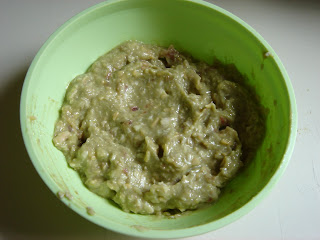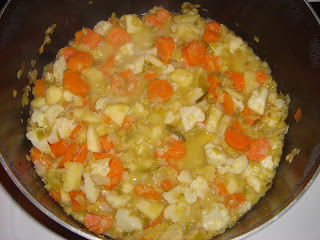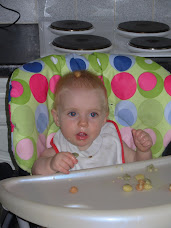My daughter's first foray into solids, after the initial iron-fortified cereal introduction, was sweet potato puree. From everything I'd gathered, sweet potatoes are universally loved by most babies because of their sweet taste, and Isabella was no exception. She loved them immediately, which wasn't always the case for other purees I'd introduce her to later on (
pureed zucchini, I'm looking at you).
To make sweet potato puree, and most other beginner purees, you need very little in the way of kitchen equipment. You'll need:
- A blender or food processor (in having tried both, I prefer the food processor because it's much easier to scrape food from)
- A potato masher
- Some ice cube trays with lids in which to freeze the food
- A spatula or other scooping utensil to spoon the puree from the blender or food processor
- Some small jelly jars to store the food in the fridge
- A vegetable steamer
- Freezer bags in varying sizes

Once you have the proper equipment, you're ready to start cooking. First, buy a whole bunch of potatoes*. Then, you can cook the sweet potatoes in one of two ways:
1. Peel the sweet potatoes, cut them into small cubes, and place them in a pot of water. Bring the water to a boil, and then let the potatoes simmer for about 20 minutes. Drain the cooked potatoes and let them cool.
Or
2. Preheat your oven to 425 degrees Fahrenheit, prick the potatoes several times with a fork, and place on a baking sheet lined with aluminum foil. Bake the potatoes for 45-60 minutes, or until the skin is fork-tender and wrinkled. Remove potatoes from the oven, and let them cool. Once cooled, peel the skin away, and cut the potatoes into cubes.
Once your potato cubes have cooled, pop them into your food processor or blender and puree with a steel blade until they're mashed.
You can easily adjust the consistency for your baby. The younger your baby, the smoother and more fluid you'll want to make the puree. Add 1-2 TBSP of water, formula, or breastmilk to thin out the puree until it's reached the consistency you need.
Next, spoon the pureed potato into your ice cube trays, cover with either plastic wrap or the ice cube trays' lids (if they came with them) and freeze the puree overnight.
 The next day, transfer the cubes to the freezer bags, and you have sweet potatoes for weeks, frozen and ready to go. I found that one cube was the perfect serving size for Isabella when she first started with purees. When her appetite grew, I just served her another cube.
The next day, transfer the cubes to the freezer bags, and you have sweet potatoes for weeks, frozen and ready to go. I found that one cube was the perfect serving size for Isabella when she first started with purees. When her appetite grew, I just served her another cube.
That's all there is to it! Believe me, if I can make baby food, with my loathing of all things cooking-and-vegetable-related, and apparently make it well enough to keep my daughter alive to see her first birthday a few weeks ago, so can you.
*I cannot stress enough how much of a time-saver it is to make your purees in large batches. When my daughter was first starting purees, I would devote a half day almost every weekend to making and freezing as many purees as I could, so that way during the week all I needed to do was pull the frozen cubes out of the freezer the night before, defrost them in the refrigerator overnight, and have all three of her meals ready to go the next day, with no cooking during the week whatsoever.






 The next day, transfer the cubes to the freezer bags, and you have sweet potatoes for weeks, frozen and ready to go. I found that one cube was the perfect serving size for Isabella when she first started with purees. When her appetite grew, I just served her another cube.
The next day, transfer the cubes to the freezer bags, and you have sweet potatoes for weeks, frozen and ready to go. I found that one cube was the perfect serving size for Isabella when she first started with purees. When her appetite grew, I just served her another cube.
